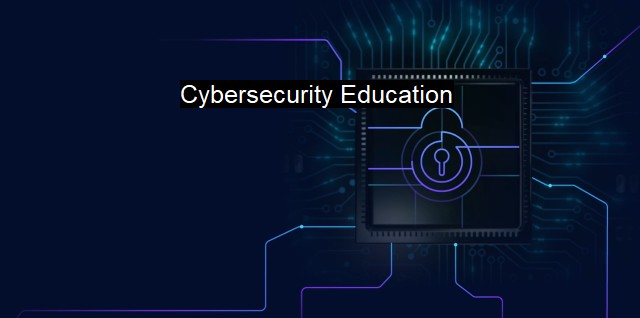What is Cybersecurity Education?
The Rising Need for Cybersecurity Education in Today's Digital Era: Preventing and Responding to Cyber Attacks while Mitigating Financial Losses
Cybersecurity Education refers to the knowledge and training pertaining to the protection of our data and computer networks from potential threats and hacking attacks. It emphasizes understanding the importance of safeguarding information, learning the potential ways our sensitive information could be threatened, and effective strategizing ways to secure the databases from these potential attacks. It harnesses a clear sense of the digital landscape and the measures available to protect against cyber frauds.The digital age brings countless benefits at our fingertips. Consequently, it also attracts an unprecedented volume of potential digital threats and cyberattacks. Severe problems such as loss of essential data, breaches of privacy disclosures, or corruption of software can occur if appropriate preventative measures are not taken. Hence, cybersecurity education gains an imperative stature in equipping the stakeholders with the knowledge to combat such challenges efficiently.
In fact, cybersecurity education should not simply be confined to tech-savvy individuals or IT departments but should be an indispensable part of training for all personnel in an organization. Employees are often the first line of defense against cyber threats and may become a vacuum of vulnerability if not appropriately educated about managing cybersecurity. Equipped with education, employees can recognize, avoid, and mitigate the risks of security threats, safeguarding the company's environment in the process.
Cybersecurity education also teaches us about the different types of cyber threats. Some of them include viruses, worms, and Trojan horses, which are categorized as malware. Malware is malicious software programmed to infect computers and result in devastating damages. Understanding malware is critical considering its widespread implications and being the universal category of cyber threats most apparent in digital environments.
Antivirus is fundamental to cybersecurity education as they are integral for the protection against malware. Antivirus software detects malicious programs and deletes them before they can harm the computer systems. It also quarantines suspicious activities and notifies the user about the potential harm, thereby allowing them preventive control over risky situations.
Different types of antivirus software work on signature-based detection, heuristic-based detection, behavioral-based detection, and sandbox detection methods to identify and mitigate cyber threats. Combining these methods delivers highly robust protection against known and unknown cyber threats. In cybersecurity education, learners are trained on how to use these antivirus programs, the typology of threats they can tackle, and update and maintenance needs.
Cybersecurity education indulges in training about firewalls and encryption. Firewalls act as a gatekeeper to thwart unauthorized access whereas encryption jumbles information into unreadable text, decipherable only by those granted permission. Understanding these aspects can enforce data privacy at multivariate levels.
Most importantly, cybersecurity education emphasizes cultivating a proactive rather than reactive approach. It emphases consistently evaluating, adjusting, testing, and enforcing security measures. Conducting regular security audits, vulnerability testing, and threat analysis becomes indispensable to adapt to progressing threats.
In a broader perspective, cybersecurity education is essential to combat the pervasive omnipresent cyber threats of our digital era. By understanding different components of cyber threats, being engaged in preventing unauthorized access, and fully comprehending the role that antivirus software plays in preventing cybercrime, individuals and organizations can build a safe and secure digital environment. Cybersecurity extends beyond technological and software solutions; it's dependent on the human agents acting on the frontline.(withIdentifierAssistant<|im_sep|>

Cybersecurity Education FAQs
What is cybersecurity education?
Cybersecurity education refers to the process of teaching individuals about the best practices, tools, and techniques for protecting their digital devices, personal information, and online activities from cyber threats such as viruses, malware, phishing, and hacking.Why is cybersecurity education important?
Cybersecurity education is crucial because cyber threats are continuously evolving, and individuals who lack the necessary knowledge and skills to protect themselves are more vulnerable to these risks. Cybersecurity education helps individuals understand the latest threats, how to identify them, and how to prevent them, thereby reducing the risk of cyberattacks and data breaches.What topics are covered in cybersecurity education?
Cybersecurity education covers a range of topics, including basic cybersecurity principles, threats and vulnerabilities, risk management, network security, data protection, incident response, and compliance regulations. It can also include training on antivirus software and other tools for protecting devices and networks from cyber threats.Who can benefit from cybersecurity education?
Anyone who uses digital devices or connects to the internet can benefit from cybersecurity education. This includes individuals, businesses, and organizations of all sizes and types, as well as students, educators, and government employees. Cybersecurity education can help individuals develop the skills and knowledge needed to protect their online activities, personal information, and systems from cyber threats.| | A | | | B | | | C | | | D | | | E | | | F | | | G | | | H | | | I | | | J | | | K | | | L | | | M | |
| | N | | | O | | | P | | | Q | | | R | | | S | | | T | | | U | | | V | | | W | | | X | | | Y | | | Z | |
| | 1 | | | 2 | | | 3 | | | 4 | | | 7 | | | 8 | | |||||||